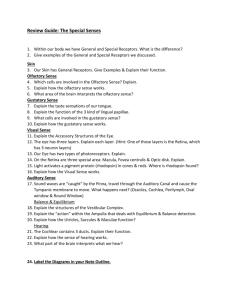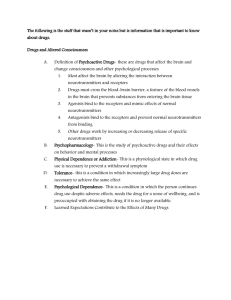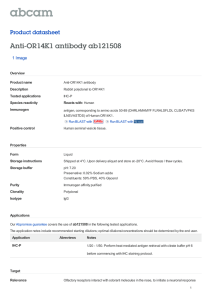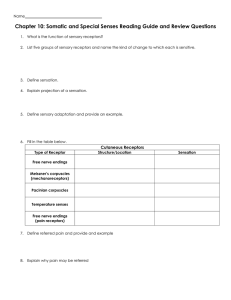Drugs and Senses Chapters 8a and 9
advertisement
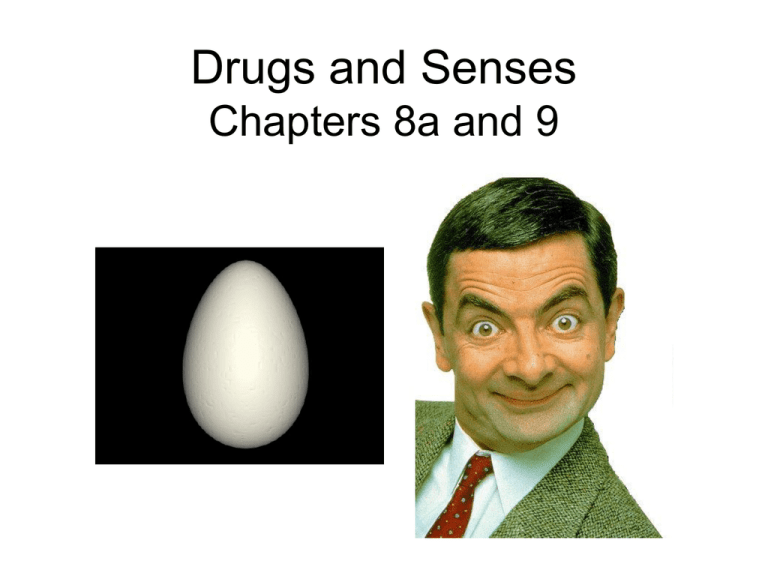
Drugs and Senses Chapters 8a and 9 What are drugs? • Chemical substances that affect the central nervous system, causing changes in physiology and often addiction. Neuromuscular Junction (NMJ) or Synapse Communication Between Neurons Normal Communication Drugs stimulate the release of a neurotransmitter Drugs inhibit the release of a neurotransmitter Drugs can bind to receptors and stimulate a response Drugs can bind to receptors and inhibit a response Alcohol • Depresses the Central Nervous System. • First blocks GABA (inhibitory neurotransmitter). • Then blocks Glutamate (excitatory neurotransmitter). http://home.howstuffworks.com/alcohol6.htm Marijuana • THC is the psychoactive ingredient in marijuana. • THC binds to anandamide receptors in the brain. • Anandamide brings on a feeling of “internal bliss.” Stimulants Excite the CNS • Cocaine – Increases the neurotransmitters dopamine and norepinephrine. – Interferes with reuptake of dopamine. – Euphoria – Fight or flight responses Amphetamines • Synthetic • Increases the neurotransmitters dopamine and norepinephrine. • Active for hours. • Inhibits the action of an enzyme that normally breaks down these two neurotransmitters. Caffeine • Blocks adenosine, an inhibitor. • Adenosine inhibits neurons from releasing neurotransmitters. Hallucinogenic Drugs • Alter sensory perception. • Increases the neurotransmitters serotonin, norepinephrine, and acetylcholine. • Increase energy levels, mood, sexuality. Opiates • Pain relief. • Bind to natural receptors that are involved in the perception of pain. – Endorphins Senses • • • • • • Sense of Taste Sense of Smell Sense of Vision Sense of Hearing Sense of Touch Sense of Equilibrium Types of Sensory Receptors • Chemoreceptor – Chemical stimuli. • Taste • Smell – Nociceptor- chemicals released by damaged tissue. • Photoreceptor – Light stimuli. • Vision • Mechanoreceptor – Mechanical stimuli. • • • • Touch Pressure Hearing Equilibrium • Thermoreceptor – Changes in temperature. • Temperature (cold and warmth receptors) Taste Buds- chemoreceptors • • • • • Numbers- 10,000 on the tongue. Shape- onion-like in morphology. Location- along the sides of papillae. Cell Division- replaced every 10 days. Structure – Taste cells. • Microvilli (=taste hairs) have receptors that generate electrical signals. – Supporting cells. • Sensitivity- respond to all 5 basic tastes, but are more sensitive to one or two than the others. Taste Buds Facial Nerve Inferior parietal Olfactory receptors- chemoreceptors • • • • • Numbers- 5 million olfactory receptors. Size and Shape- similar to a postage stamp. Location- roof of the nasal cavity. Cell Division- replaced every 60 days. Structure – Olfactory receptor cells. • Olfactory cilia with odorant receptors. – Supporting cells. • Sensitivity- 1,000 different types of receptors, each controlled by a different gene. Together able to detect 10,000 different odors. Olfactory Cell Location and Anatomy • Olfactory glands produce mucus that dissolves odorants. Temporal Lobe and Limbic System Temporal lobe Olfactory nerve Olfactory bulb Amygdala Sense of Vision- photoreceptors • Numbers- ¼ billion photoreceptors. • Eye- 25 mm in diameter (1 inch). • Eyes- contain 70% of all the sensory receptors in the human body. • The eyeball has three layers – Sclera- the white of the eye. – Choroid- contains melanin that absorbs light. – Retina- contains photoreceptors. • The retina contains 2 types of photoreceptors. – Rods- responsible for black and white vision. – Cones- responsible for color vision. Iris and Pupil • Iris- regulates the amount of light that enters the eye. – Smooth muscle fibers automatically adjust the size of the pupil. • Pupil- opening at the center of the iris. Bright Dim Light Dark Iris Pupil Dilated vs. Constricted Pupils • Dilate- pupil becomes larger. • Constrict- pupil becomes smaller. • 16 fold variation between constricted and dilated. Constricted Normal Dilated Cornea and the Choroid • Cornea and Lensrefract (bend) light rays and focus light on the retina. Retina Cornea Lens • Albert Einstein- proposed the Particle Model of Light Theory in 1905. – Visible light is composed of particles of energy called photons. Photoreceptors in the Eye Structure and Function of the Retina Optic Nerve Occipital Lobe Abnormalities of the Eye • Distance Vision – Nearsighted • Close objects are seen clearly. • Long eyeball causes image to focus in front of the retina. – Farsighted • Distant objects are seen clearly. • Short eyeball causes image to focus behind retina. • Astigmatism • Image is blurred. • Irregular curvature of the cornea or lens causes light rays to focus unevenly. Abnormalities of the Eye #2 • Color blindness – Colors cannot be distinguished. – 75% of people have poor green perception. – 8-10% of males, <1% females. • X-Linked. – A lack of or reduced number of one of the cone types. 4 Sex-Linked Traits: 1. Normal Color Vision: A: 29, B: 45, C: --, D: 26 2. Red-Green Color-Blind: A: 70, B: --, C: 5, D: -3. Red Color-blind: A: 70, B: --, C: 5, D: 6 4. Green Color-Blind: A: 70, B: --, C: 5, D: 2 Humors • Vitreous Humor – Embryonic, never replaced. – Posterior chamber. – Keeps the eyeball from collapsing. • Aqueous Humor – Drained and replaced every 90 minutes. – Anterior chamber. – Supplies the cornea and lens with nutrients and oxygen. Glaucoma Cataracts • Leading cause worldwide of blindness. • A lens becomes cloudy or opaque. • Caused by – – – – – Natural aging. 50 or over. Drug reactions. Injury. Diabetes. UVB damage. • At risk – Smokers (2X). – Guys named “Phil” and “Rupert”. • Treatment- surgery, removal and replacement of the lens. Sense of Hearing • Vibrating objects create pressure waves in the air or water= sound. • Pressure waves vary in – Amplitudevolume. – Frequencypitch. Anatomy of the Ear Receiver Amplifier Transmitter Section of the Cochlea • There are 3 compartments in the cochlea – Upper compartment- vestibular canal. – Central compartment- cochlear duct. • Contains “Organ of Corti.” – Lower compartment- tympanic canal. Temporal lobe Vestibulocochlear Nerve Sense of Equilibrium • Rotational Equilibrium – Cupula movement within the semicircular canals detects rotation and/or angular movement of the head. • Gravitational Equilibrium – Movement of the otolithic membranes within the utricle and saccule is detects movement of the head in vertical and horizontal planes. Rotational Equilibrium Gravitational Equilibrium Vestibulocochlear Nerve
